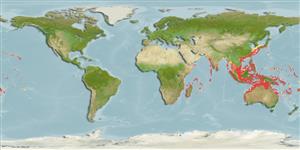Actinopterygii (ray-finned fishes) >
Perciformes (Perch-likes) >
Polynemidae (Threadfins)
Etymology: Polydactylus: Greek, poly = a lot of + greek, daktylos = finger (Ref. 45335).
Environment / Climate / Range
Ecology
Marine; brackish; demersal; depth range ? - 122 m (Ref. 57343). Tropical, preferred ?; 37°N - 35°S, 22°E - 148°W (Ref. 57343)
Indo-Pacific: East Africa to French Polynesia, north to Japan, south to Australia. Has not been collected from the Red Sea or Persian Gulf (Ref. 57343).
Size / Weight / Age
Maturity: Lm ? range ? - ? cm
Max length : 45.0 cm SL male/unsexed; (Ref. 57343); common length : 30.0 cm TL male/unsexed; (Ref. 30573); max. published weight: 1.7 kg (Ref. 40637)
Dorsal
spines
(total): 9;
Dorsal
soft rays
(total): 13;
Anal
spines: 2;
Anal
soft rays: 11 - 12. Golden, dusky olive brown above, scale rows each with a dark line; fins dusky (Ref. 5492). Body with 7 or 8 prominent dark stripes along the longitudinal scale rows above lateral line and 7-9 faint stripes below. Pectoral fin rays unbranched; 4th or 5th pectoral filament longest, 22-40% of SL. Posterior margin of maxilla reaching to (or slightly extending beyond) level of posterior margin of adipose eyelid. Lower tip of 7th proximal pterygiophore of 1st dorsal fin directed backwards. Lateral squamation on caudal fin unbranched (Ref. 40970).
Occur over muddy bottoms of the continental shelf (Ref. 4340), from estuaries to coastal beaches and to relatively deep waters (less than 122 m) (Ref. 57343). Forms loosely-associated schools (Ref. 57343). Feeds on small crustaceans, fishes and other benthic organisms (Ref. 30573). Fish of 12 cm can be caught in large numbers (Ref. 9685).
Life cycle and mating behavior
Maturity | Reproduction | Spawning | Eggs | Fecundity | Larvae
Motomura, H., 2004. Threadfins of the world (Family Polynemidae). An annotated and illustrated catalogue of polynemid species known to date. FAO Spec. Cat. Fish. Purp. Rome: FAO. 3:117 p. (Ref. 57343)
IUCN Red List Status (Ref. 115185)
CITES (Ref. 94142)
Not Evaluated
Threat to humans
Harmless
Human uses
Fisheries: commercial; aquaculture: commercial; gamefish: yes
More information
Common namesSynonymsMetabolismPredatorsEcotoxicologyReproductionMaturitySpawningFecundityEggsEgg development
ReferencesAquacultureAquaculture profileStrainsGeneticsAllele frequenciesHeritabilityDiseasesProcessingMass conversion
Tools
Special reports
Download XML
Internet sources
